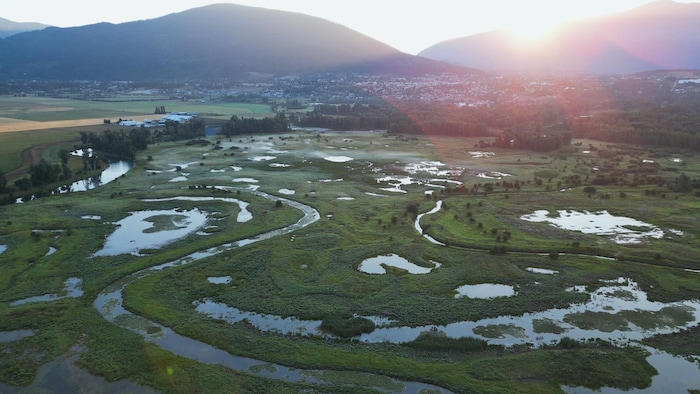Open in full screen mode The Yaqan Nukiy project aims to restore nearly 520 hectares of wetlands that were disconnected from the surrounding river system in the 1960s by a series of ditches, dikes, pumps and drains. The Canadian Press Norm Allard knows he may never see the full impacts of his efforts to restore wetlands and floodplains in southeastern B.C., but he takes a “generational view” of the work which illustrates a key element of climate resilience. We don't just do this for ourselves during our lives. It's a longer-term vision, says Allard, community planner for Yaqan Nukiy (another name for the Lower Kootenay Band), nestled between the Goat and Kootenay rivers near Creston, British Columbia. Maybe it's our grandchildren who will benefit, he said, referring to the restoration project of nearly 520 hectares of wetlands that were disconnected from the surrounding river system in the 1960s by a series of ditches, levees, pumps and drains. Mr Allard explains that much of this infrastructure had been removed since the project began in 2017, reopening the natural links between the wetland and neighboring rivers. Today, areas that were dry in early August are rehydrated enough to retain water year-round, effectively building resilience to flooding and drought, so that the region is experiencing wetter rains and drier droughts with climate change, he says. Loading ELSE ON INFO: When consumers rush to Costco to buy… gold bars Wetlands and floodplains are like a huge sponge. They absorb [water] and then release it all back into the system over time, says Allard. The consequences of Both a lack and excess of water have been devastating to communities across British Columbia in recent years. The Yaqan Nukiy project is an example of a nature-based approach to adapting as drought, floods and wildfires threaten public safety, critical infrastructure, agriculture, tourism and the survival of wild salmon populations in British Columbia. Oliver Brandes leads the POLIS Water Sustainability Project research group, based at the #x27;global studies from the University of Victoria, says the most important solution is to keep natural infrastructure healthy. We need to make the landscape work like it used to, and we also need to make sure we reduce inappropriate development that will impact [water ], because we will have to pay for it in the future, says Mr. Brandes. Stop paving groundwater recharge areas, he adds. This is the best type of storage you have. It's natural, it's free. This has worked since time immemorial. The costliest weather disaster in British Columbia's history occurred in November 2021, when rivers of atmospheric rain caused landslides that killed five people. Widespread flooding submerged homes and farmland and damaged critical road and rail connections between southwestern British Columbia and the rest of Canada.
When consumers rush to Costco to buy… gold bars
The Sumas Prairie region of the Fraser Valley, which includes many farms, was particularly hard hit by flooding in 2021. (File photo)
The flooding followed an extreme heatwave that killed more than 600 people in British Columbia, and the province issued drought advisories throughout the summer.< /p>
Since then, dry conditions have worsened. Historically low water flows killed hundreds of salmon in the Cowichan River last summer, while the province issued several orders restricting irrigation of forage crops and ranchers in the Cowichan River x27;interiors of the country had to sell their livestock due to the shortage of animal feed.
At a September press conference, British Columbia's Emergency Management Minister Bowinn Ma called the drought a sleeping giant of a natural disaster.
At the time, about 80 per cent of British Columbia's population was classified as drought level four or five, the two highest rankings on the scale, hampering the fight against drought. against wildfires that ravaged more than 28,000 square kilometers of land last season.
The drought map shows that a large Part of northeastern British Columbia is still classified at level five, while much of the central interior is at level three or four.
Alouette Lake in Golden Ears Park, in Maple Ridge, was one of those bodies of water that was heavily impacted by the drought l 'last summer.
Brandes describes wildfires, floods, drought and contamination as the four horsemen of the water apocalypse. The links between them are evident after more than a century of industrial and urban development in the province, he says.
You remove some of the vegetation cover, like trees, you remove riparian areas, you asphalt areas, you make them more vulnerable, he said, referring to flooding and drought. Add to that the forest fires and subsequent drinking water problems, he continues.
Nathan Cullen, who leads the province's new Ministry of Water, Land and Resource Management, argues climate change is bringing British Columbia into a new reality.
In the past, droughts in British Columbia were generally localized and short-lived, he says. extend over entire landscapes, even across the entire province, and last much longer, says the minister, recognizing that the province is catching up.
Cullen says B.C.'s efforts to modernize land use planning aim to integrate all values, including biodiversity and ecosystem health.
The British Columbia government is working on a watershed security strategy scheduled for release next year. An Intents Document (New Window) shows priority areas include strengthening local capacity and addressing gaps in provincial watershed data and use of water resources. water, as well as balancing water supply and demand, in part using the full range of tools under the Water Sustainability Act.
The document also outlines plans to strengthen Indigenous leadership in watershed governance and restoration and identifies wild salmon recovery as a key value.
The provincial government launched a $100 million fund for projects supporting watershed security with the release of its intent document last March.
The fund builds on the $27 million provincial Healthy Watershed Initiative, through which Yaqan Nukiy restoration project received funding.

